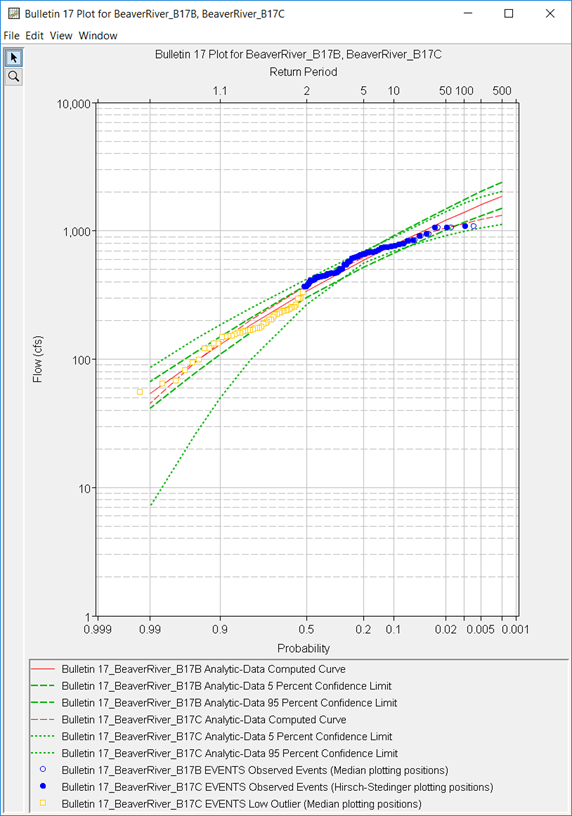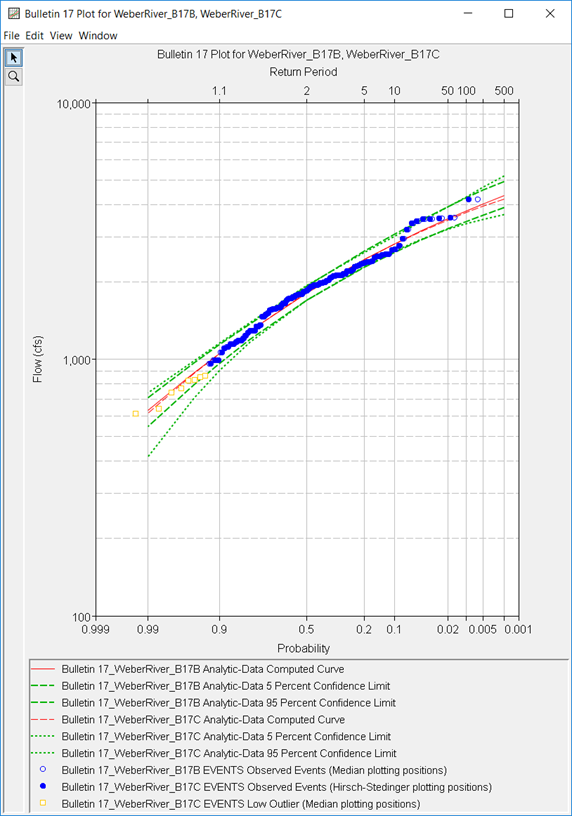Download PDF
Download page Optional Task. Compare B17B and B17C Low Outlier Procedures.
Optional Task. Compare B17B and B17C Low Outlier Procedures
Return to Optional Task. Analyze the East Fork Big Creek Data Set Using B17B Methods.
Background
Log Pearson Type III distributions fit to the annual maximum series for the Beaver River near Beaver, UT and Weber River near Oakley, UT gaging stations offer an interesting comparison of Bulletin 17B and Bulletin 17C procedures.
- Create two Bulletin 17 analysis using the Beaver River annual maximum series (one for B17B procedures and one for B17C procedures).
- Similarly, create two Bulletin 17 analysis using the Weber River annual maximum series.
- For each analysis, leave all of the default options enabled; no changes are required.
Once each analysis has been created and computed, investigate the differences between the resulting Log Pearson Type III statistics when using B17B and B17C procedures. Specifically, identify the number of systematic events, number of low outliers, and the percentage of systematic events screened when using the default B17B procedures (Single Grubbs-Beck low outlier test) and B17C procedures (Multiple Grubbs-Beck low outlier test).
Question: Fill out Table 1 and Table 2.
Table 1. Beaver River LPIII Statistics Comparison
Gage | Procedures | Mean | Std. Dev. | Skew | Systematic Events | # Low Outliers | # of Low Outliers / # of Syst. Events |
|---|---|---|---|---|---|---|---|
Beaver River | B17B | ||||||
B17C |
Table 2. Weber River LPIII Statistics Comparison
Gage | Procedures | Mean | Std. Dev. | Skew | Systematic Events | # Low Outliers | # of Low Outliers / # of Syst. Events |
|---|---|---|---|---|---|---|---|
Weber River | B17B | ||||||
B17C |
Gage | Procedures | Mean | Std. Dev. | Skew | Systematic Events | # Low Outliers | # of Low Outliers / # of Syst. Events |
|---|---|---|---|---|---|---|---|
Beaver River | B17B | 2.512 | 0.304 | -0.329 | 102 | 0 | 0% |
B17C | 2.535 | 0.304 | -0.813 | 102 | 49 | ~48% |
Gage | Procedures | Mean | Std. Dev. | Skew | Systematic Events | # Low Outliers | # of Syst. Events / # of Low Outliers |
|---|---|---|---|---|---|---|---|
Weber River | B17B | 3.244 | 0.168 | -0.453 | 111 | 0 | 0% |
B17C | 3.245 | 0.168 | -0.524 | 111 | 8 | ~7% |
Question: Open the Report file for the Beaver River B17C analysis. What was the computed low and high flow range for 1917? What was the computed low and high flow range for 1918? Why does one year use a flow range of 0 (i.e. peak value = low value = high value) and the other year use a flow range < > 0 (i.e. peak value < > low value < > high value)?
The Expected Moments Algorithm works in conjunction with the Multiple Grubbs-Beck low outlier test. If any flows are found to be below the computed low outlier threshold, then the perception threshold for all years with systematic or historical data is replaced with the computed low outlier threshold as the low value. Then, for years in which the flow rate is found to be below the computed threshold, the input flow range is replaced with 0 as the low value and the computed low outlier threshold as the high value.
For the analysis in question, the computed low outlier threshold using the Multiple Grubbs-Beck test was found to be 364 cfs. Since multiple events were found to be below this threshold value, the perception threshold for all years with systematic or historical data was replaced with [364 – inf].
For 1917, the peak flow rate was 610 cfs, which is greater than 364 cfs. Therefore, no changes to the input flow range were made during the computations. For 1918, the peak flow rate was 238 cfs, which is less than 364 cfs. Therefore, the input flow range was changed to [0 – 364 cfs].
Question: Using the information contained on the Tabular Results tab of each analysis, fill out Table 3 and Table 4.
Table 3. Beaver River B17B vs. B17C Flow Frequency Comparison
Recurrence Interval | Annual Chance Exceedance | Peak Flow (cfs) | |
|---|---|---|---|
Beaver River | |||
B17B | B17C | ||
500 | 0.2 | ||
200 | 0.5 | ||
100 | 1 | ||
50 | 2 | ||
20 | 5 | ||
10 | 10 | ||
Table 4. Weber River B17B vs. B17C Flow Frequency Comparison
Recurrence Interval | Annual Chance Exceedance | Peak Flow (cfs) | |
|---|---|---|---|
Weber River | |||
B17B | B17C | ||
500 | 0.2 | ||
200 | 0.5 | ||
100 | 1 | ||
50 | 2 | ||
20 | 5 | ||
10 | 10 | ||
The results of the BeaverRiver_B17B and BeaverRiver_B17C analyses are compared against one another within Figure 1.
Beaver River Results

Recurrence Interval | Annual Chance Exceedance | Peak Flow (cfs) | |
|---|---|---|---|
Beaver River | |||
B17B | B17C | ||
500 | 0.2 | 1850 | 1330 |
200 | 0.5 | 1590 | 1230 |
100 | 1 | 1400 | 1140 |
50 | 2 | 1200 | 1050 |
20 | 5 | 960 | 900 |
10 | 10 | 780 | 770 |
The quantiles noted above have been rounded.
The results of the WeberRiver_B17B and WeberRiver_B17C analyses are compared against one another within Figure 2.
Weber River Results

Recurrence Interval | Annual Chance Exceedance | Peak Flow (cfs) | |
|---|---|---|---|
Weber River | |||
B17B | B17C | ||
500 | 0.2 | 4330 | 4210 |
200 | 0.5 | 4030 | 3940 |
100 | 1 | 3790 | 3720 |
50 | 2 | 3520 | 3480 |
20 | 5 | 3140 | 3120 |
10 | 10 | 2820 | 2810 |
The quantiles noted above have been rounded.
Question: In your opinion, which set of procedures (B17B or B17C) provides a better fit to the systematic data for the Beaver River and Weber River annual maximums series? How comfortable are you screening ~50% of the systematic data?
This is a subjective question and meant to incite discussion.